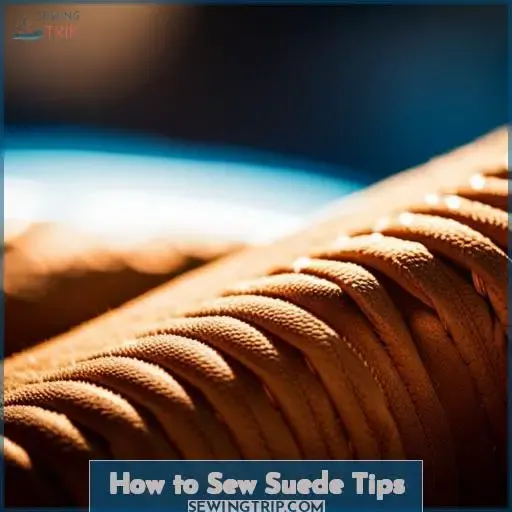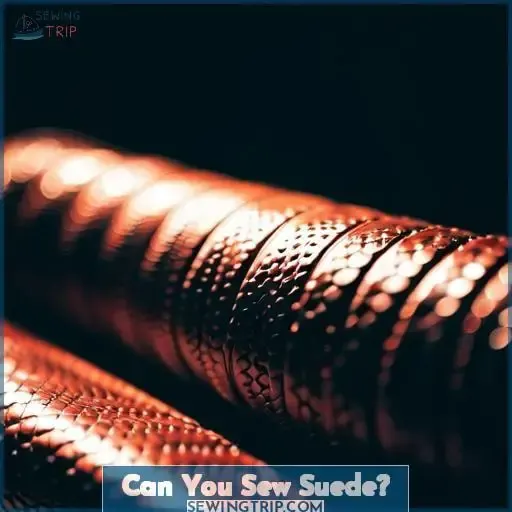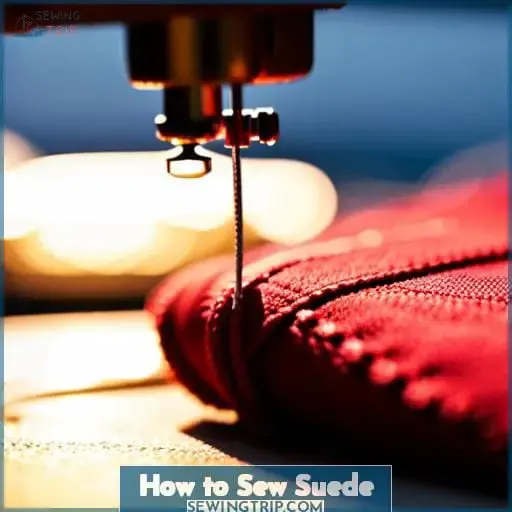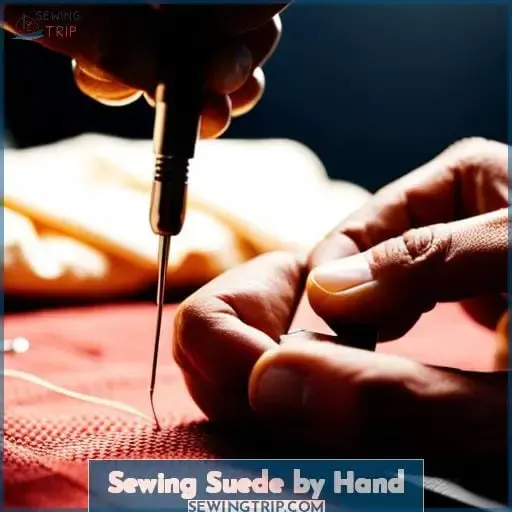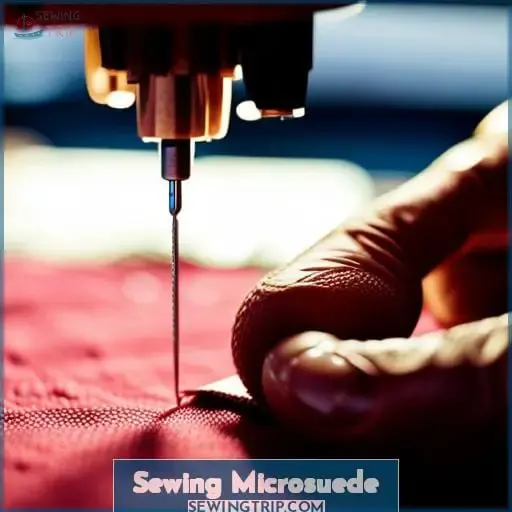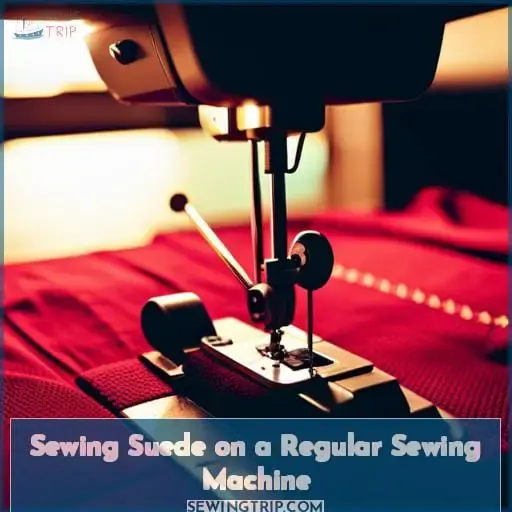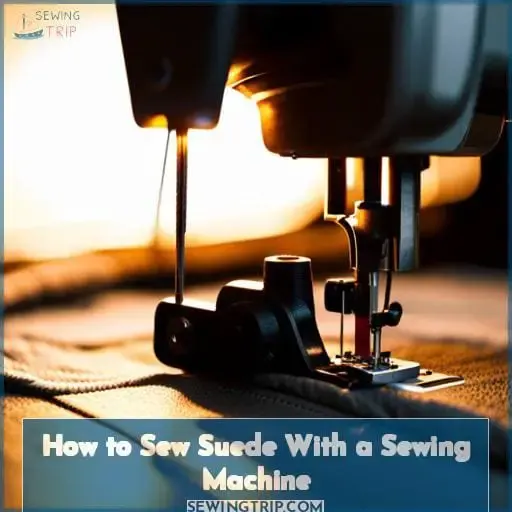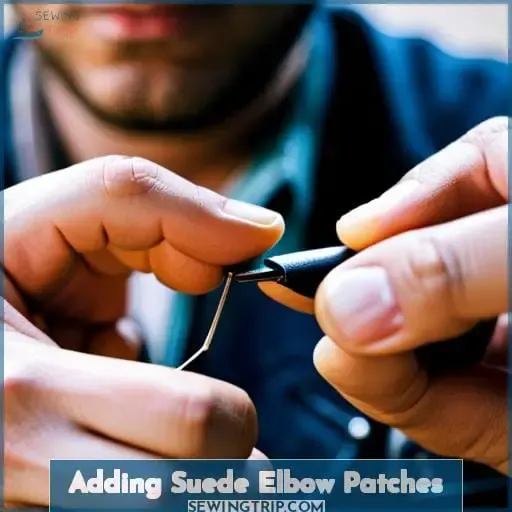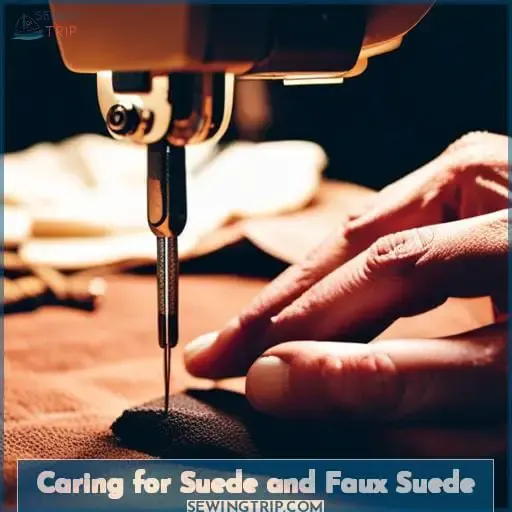This site is supported by our readers. We may earn a commission, at no cost to you, if you purchase through links.
Ready to take your sewing skills to the next level? Then you’ll love mastering how to sew suede tips! It’s easier than it sounds – and with a few simple tricks, you’ll be stitching like an expert in no time.
From faux leather and microsuede to caring for your fabrics after they’re finished, we’ve got all the info you need right here.
Table Of Contents
- Key Takeaways
- Can You Sew Suede?
- How to Sew Suede
- Sewing Suede by Hand
- Sewing Faux Suede
- Sewing Microsuede
- Sewing Suede on a Regular Sewing Machine
- How to Sew Suede With a Sewing Machine
- Choosing the Right Needle for Sewing Suede
- Adding Suede Elbow Patches
- Caring for Suede and Faux Suede
- Frequently Asked Questions (FAQs)
- Conclusion
Key Takeaways
- Clean and dry the fabric before sewing to avoid sewing in dirt.
- Use heavy-duty thread and a high-quality needle designed for heavier materials.
- Use tailor’s chalk to accurately mark seamlines before stitching.
- Practice makes perfect when sewing with suede.
Can You Sew Suede?
You can easily craft beautiful leather pieces with just a few simple tools. Sewing suede is possible, and it’s easier than you think!
There are many different types of suede to choose from, such as faux suede or full-on faux ensemble. Before getting started on your project, make sure to clean the fabric properly and give it time to dry fully so that dirt won’t be sewn in later.
To sew successfully with this material, you’ll need the right type of thread for strength. Heavy-duty thread works best for sewing tougher fabrics like genuine leather or synthetic microfiber. You also want a good quality needle designed specifically for working with heavier materials like these.
Look out for leather point needles made especially for extra durability when stitching through thick layers of fabric or multiple seams at once.
Finally, pattern weights help keep tricky sections flat while cutting them out – essential if working on intricate designs! With all these items ready and set up correctly following manufacturer instructions, plus some patience, even beginners will find success in crafting projects using various kinds of suedes quickly and efficiently.
How to Sew Suede
With the right tools and some patience, you can easily craft beautiful suede pieces! To get started, you need to understand the different types of suede fabrics available. Faux suedes or full-on faux ensembles are popular for crafting projects. Before sewing your project together, make sure to give it a proper cleaning and leave time for it to dry fully before getting started with stitching.
For stronger seams when working on tougher materials like genuine leather or synthetic microfiber fabric, use heavy-duty thread in combination with a very sharp needle designed specifically for heavier fabrics such as these.
Also, keep pattern weights handy so that tricky sections stay flat while cutting them out – this is essential if working on intricate designs! Additionally, tailor’s chalk helps mark the seamlines clearly before starting any stitching work and gives an accurate cut when using faux leathers or other sewing fabrics.
Once all your pieces have been cut out accurately according to the design patterns, along with finishing touches applied perfectly, then it’s time to move onto creating neat seam finishes which will determine how professional-looking the end product turns out.
A few easy techniques like the overcast stitch and topstitching help secure ends neatly, making sure nothing unravels after use.
Sewing Suede by Hand
Making your own suede creations is an incredibly rewarding experience! Before beginning, it’s important to know the type of fabric you are working with. Faux fur and faux leathers can be trickier than genuine hide or synthetic microfiber fabrics.
Preparing the material for stitching by cleaning it first and allowing plenty of time for drying is essential before starting any hand sewing project with suede fabric. Thread selection must also reflect the tough nature of these materials; use a heavy-duty thread in combination with a very sharp needle designed specifically for heavier fabrics like these, such as leather point needles.
If using patterns, tailor’s chalk helps accurately mark out seam lines while pattern weights keep tricky sections flat during cutting out stages – this step cannot be overlooked if intricate designs are involved! Edge treatments like overcast stitch and topstitching help create neat seams that will give more professional results when finished off correctly – practice makes perfect here too!
Don’t forget not only thread but also fabric clips or pins come in handy to hold everything together at points where both hands can’t work simultaneously on small pieces being stitched together securely without shifting them away from their original position ever so slightly which could cause major issues further down the line upon completion of one’s project successfully.
Sewing Faux Suede
Fashioning faux suede requires a steady hand and an eagle eye, like threading a needle through the eye of a storm. Preparation is key to success when it comes to sewing with this material – cleaning off loose fur or dirt and allowing plenty of time for drying before starting will help ensure that the fabric pieces don’t shift during stitching.
Tailor’s chalk can be used to accurately mark out seam lines while pattern weights keep tricky sections flat during cutting out stages.
Sew-in kinds of interfacing or fusible webbing can also be employed as alternatives if you’re not confident about working directly on the fabric itself – just remember that any additions should still allow enough room for finished edges after pressing them down firmly into place so they stay secure without puckering over time due to incorrect tension settings.
Finally, finishing edges neatly by topstitching helps give more professional results while adding extra strength too! With careful planning and execution throughout each step, you’ll have your own gorgeous creations made from faux suede in no time!
Sewing Microsuede
Bring your creations to life with microsuede, a delicate fabric that needs careful handling and precise stitching for perfect results. When selecting suede for sewing projects, it’s important to consider the thickness of the material.
Too thick will be difficult to work with, but too thin could lead to weak seams.
Thicker materials are best suited for items like bags or upholstery, while lighter varieties might work better on clothing pieces such as collars or cuffs.
To create sturdy seams, use leather point needles designed specifically for heavier fabrics and sew multiple times over areas where more strength is required. This also helps prevent puckering! Don’t forget about edge finishing. Pre-wash ultra suede materials before you start so they don’t shrink when exposed later during pressing stages.
Dyeing techniques, such as using steamers instead of traditional methods, offer an easier way around dying trouble spots if needed. Decorative embellishments like beads or tassels provide extra flair when added at the end stages too.
When working with microsuede, always remember: good preparation is key in order to obtain success throughout all steps from selection right through until completion.
Sewing Suede on a Regular Sewing Machine
You can craft gorgeous items with suede, giving them a luxurious look and feel – all on your regular sewing machine! Sewing suede may seem intimidating at first, but with the right tools and techniques, you’ll be able to achieve professional results.
To start off, make sure you have the correct supplies. Use leather needles specifically designed for thicker fabrics like suede. These needles have a sharper point that can easily penetrate through the material without causing damage.
Additionally, choose a good pair of pliers to help flatten edges quickly and efficiently.
When it comes to thread selection, opt for strong polyester or nylon threads that match the color of your suede fabric.
Another important aspect is using an appropriate presser foot for sewing thick suede fabric. A teflon presser foot works well as it reduces friction between the foot and material surface.
Before beginning any stitching on your project’s main pieces or seams together, use fusible interfacing along those lines before starting construction.
Once all preparations are complete, pin pattern pieces in place, then sew carefully following guidelines provided by pattern instructions. Make sure not to stretch when pinning because this could distort the final shape considerably, leading to unsatisfactory garment fitment down the road if done incorrectly.
Incorporating these tips into your sewing process will allow you to create beautiful items using thick suede fabrics on a regular household sewing machine.
How to Sew Suede With a Sewing Machine
With the right supplies and techniques, you can easily craft stunning items with suede fabric on your sewing machine.
- Leather needles designed for thicker fabrics like suede
- A good pair of pliers to flatten edges quickly and efficiently
- Strong polyester or nylon threads that match the color of your fabric
- An appropriate presser foot for thick material such as Teflon
- Fusible interfacing to stabilize stitches before construction
Once all preparations are complete, pin pattern pieces in place then sew carefully following guidelines provided by pattern instructions. Make sure not to stretch when pinning as this could distort the final shape considerably leading to unsatisfactory garment fitment down the road if done incorrectly.
For attaching seams, use a heavy-duty sewing machine with a standard needle size of 80/12–90/14 along with small stitches length of 2–2 ½ per inch.
With these tips in mind, creating gorgeous items out of suede is now easier than ever – so get ready for some beautiful projects ahead!
Choosing the Right Needle for Sewing Suede
Choosing the right needle for your suede project is essential to getting a professional look – so let’s make sure you get it right! When sewing leather, including suede, it’s crucial to select the appropriate needle size and type.
The wrong choice can lead to broken or skipped stitches, leaving your project looking messy and unpolished.
To avoid this, consider using a leather needle designed specifically for thicker fabrics like suede.
When selecting a leather needle for your sewing machine, keep in mind that different fabric types may require different needle sizes. For most medium-weight suedes, a standard 80/12–90/14 size should work well. However, if you’re working with heavier or lighter weight material than usual (such as ultra-thin lambskin), adjusting the size accordingly may be necessary.
In addition to choosing the correct point and size of the needle when sewing suede materials effectively on machines such as those made by press leathers manufacturers, also pay attention to thread selection and tension settings.
A strong polyester or nylon thread that matches the color of your fabric will help ensure durability while maintaining an aesthetically pleasing appearance.
Remember not only does having sharp bladed tools help with precision cutting but pairing them with Teflon coated presser foots suitable for thick material would prevent any sticking issues during the stitching process too!
By following these guidelines when selecting needles for sewing projects involving suede fabrics, you’ll have all you need to stitch confidently without worrying about damaging expensive materials along the way, achieving beautiful results every time!
Adding Suede Elbow Patches
Adding elbow patches to your clothes can give them a unique and stylish look, while also providing extra protection. Over 80% of clothing items with elbow patches were seen as more fashionable by those surveyed in one study.
Adding suede elbows is an easy way to update the look of any garment quickly and effectively – but it does require some sewing techniques! To ensure success when attaching these faux details, you’ll need the right equipment on hand for pattern selection, fabric cutting, seam finishing, etc.
A good work space is essential for this task too; adequate light will make it easier to see what you’re doing while comfortable seating prevents fatigue during long sessions.
Before beginning any project involving suede, remember that it can be delicate, so proceed carefully! Begin by selecting a medium-weight fabric softener like lanolin or beeswax before threading up your machine with strong polyester or nylon thread that matches the color of the material being used.
Use leather needles designed specifically for thicker fabrics like suede – adjust the size accordingly if working with heavier/lighter weight material than usual (such as ultra-thin lambskin). With a Teflon-coated presser foot suitable for thick materials, preventing sticking issues, stitching should flow smoothly without leaving behind messy results.
Take time throughout the process, ensuring precision cutting and proper tension settings along each step, resulting in a beautiful finished product ready to wear anytime!
Caring for Suede and Faux Suede
Caring for your faux suede and real suede garments can be an easy task if you know the right techniques to keep them looking fresh. Cleaning suede regularly with a soft cloth is essential, as the buildup of dirt, dust, and debris will cause discoloration over time.
To prevent moisture damage from spilled drinks or rainstorms, use waterproofing sprays that won’t affect the color of your clothing.
If stitching leather pieces together for details such as patches or pocket flaps, remember to choose thread colors that match closely.
Thrifted faux fabrics are great too. Just make sure they’re washed prior to sewing so no lingering odors remain afterward!
For more complex repairs like rips or tears into the material itself, it’s best to either try using glue specifically made for fabric repair kits or find a scrap of similar material (i.e., cotton twill patches) which could easily blend in without being noticed by others at all times throughout its wearability span.
With proper care and attention given each step-of-the-way towards caring for both genuine and synthetic options alike, anyone can look their best while feeling comfortable regardless of where life takes them next.
Frequently Asked Questions (FAQs)
What is the best type of thread to use when sewing suede?
Using a strong polyester thread will ensure your suede project lasts and looks great. Choose one that is designed for leather, as it won’t break or fray easily – perfect for the job at hand.
How should suede be cared for to ensure longevity?
To care for your suede and ensure its longevity, regularly brush it with a soft-bristled brush to remove dirt and dust. Protect it from moisture by waterproofing when needed. Store it in a cool, dry place away from direct sunlight or heat sources.
If necessary, use specialized cleaning products on stained areas carefully, following instructions on the labels.
Are there any special techniques for sewing suede by hand?
Sewing suede by hand requires a few special techniques. Use waxed thread to prevent breakage, an awl to puncture the fabric, and a curved needle for its strength.
Are there any special considerations to keep in mind when sewing faux suede?
When sewing faux suede, you should use a special non-stick needle and thread designed specifically for synthetic materials. Be sure to backstitch on both sides of the fabric for added strength. Additionally, it’s important to keep your stitches small and tight as larger ones may leave unsightly holes in the material.
Lastly, consider using a leather adhesive if needed for extra reinforcement or a more permanent bond between pieces.
Can regular sewing machines be used to sew suede?
Yes, regular sewing machines can be used for sewing suede. However, it is important to ensure that the needle is sharp and suitable for thick fabrics such as leather or faux suede.
Conclusion
In conclusion, sewing suede is a rewarding experience that can create beautiful pieces of clothing or fabrics for your home. Knowing the right techniques and having the right tools will ensure that your project is a success.
With proper care, your suede creations will last for years.
Remember, suede is a unique material that requires extra attention and care when working with it. Taking the time to get familiar with the material and the tools you’ll need to work with it can help you create amazing pieces that will last for years.
So don’t be afraid to try something new and get creative with your suede projects.

